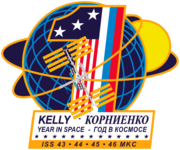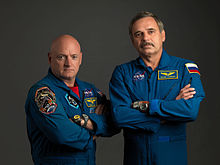
Back بعثة السنة الكاملة لمحطة الفضاء الدولية Arabic Aasta kosmoses Estonian ISS year long mission Finnish One Year Mission Italian Missão de um ano na EEI Portuguese
| Mission type | Long-duration expedition |
|---|---|
| Mission duration | 340d 8h 43m |
| Orbits completed | 5,356 [1] |
| Expedition | |
| Space station | International Space Station |
| Began | March 27, 2015, 19:42 UTC |
| Ended | March 2, 2016, 04:25 UTC |
| Arrived aboard | Soyuz TMA-16M |
| Departed aboard | Soyuz TMA-18M |
| Crew | |
| Crew size | 2 |
| Members | |
| EVAs | 4 |
| EVA duration | 23h54m |

 Scott Kelly and Mikhail Kornienko | |
The ISS year-long mission , also called the One-Year Mission, was an 11-month-long scientific research project aboard the International Space Station, which studied the health effects of long-term spaceflight.[2]
The NASA Twins Study was conducted. Astronaut Scott Kelly is selected for the mission with his identical twin, Mark Kelly, on earth as control group. Scott spent 340 days in space for the experiment. The result demonstrated several long-lasting changes, including those related to alterations in DNA and cognition.[3][4]
- ^ Spacefacts
- ^ Jeffrey Kluger (18 Dec 2014). "Meet the Twins Unlocking the Secrets of Space: NASA's One-Year Mission with Mark and Scott Kelly". Time. Retrieved 2015-12-14.
- ^ Zimmer, Carl (12 April 2019). "Scott Kelly Spent a Year in Orbit. His Body Is Not Quite the Same - NASA scientists compared the astronaut to his earthbound twin, Mark. The results hint at what humans will have to endure on long journeys through space". The New York Times. Retrieved 12 April 2019.
- ^ Garrett-Bakeman, Francine E.; et al. (12 April 2019). "The NASA Twins Study: A multidimensional analysis of a year-long human spaceflight". Science. 364 (6436): eaau8650. Bibcode:2019Sci...364.8650G. doi:10.1126/science.aau8650. PMC 7580864. PMID 30975860.